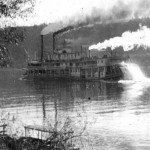Even before the U.S. officially entered the second world war, Congress authorized increased spending for the manufacture of arms for sale to the allied forces. The passage of the first national defense appropriations act in June 1940 quickly resulted in the construction of the world’s largest smokeless powder plant near Charlestown, Indiana.
Large tracts of inexpensive, undeveloped land with a readily available water supply made it an ideal site for the location of the Indiana Army Ammunition Plant, or INAAP. The government owned facility–run by the independent contractor DuPont–consisted of Indiana Ordnance Works, known as “the powder plant,” the Hoosier Ordnance Plant, a packaging unit, and a never-completed third section.
The location of the plant in Charlestown was a salve to economic hardships brought on by the Great Depression and the Ohio River Flood of 1937. Workers flocked from three states to relocate in Charlestown.
What had previously been a bedroom community for Louisville swelled in population from 900 to 13, 400 over the second half of 1940. The town’s physical and governmental infrastructure was completely unprepared for the boom, resulting in traffic congestion, housing shortages, crime, disease, and educational setbacks.
In time, the city’s sewer system was completed, public health measures were implemented and Highway 62 constructed to handle the influx of commuters. Adequate schools were established only after many of the school-age children had left the area.
At its peak, the INAAP employed 27, 520 people, including greater-than-average numbers of women and blacks. After the war, the facility served as a storage depot, resuming production during the conflicts in Korea and Vietnam.
After DuPont, contractors operating the plant included Good Year, Olin Mathieson and ICI. Charlestown’s prosperity followed the cycle of the INAAP’s activity, which dwindled to a workforce of 380 in 1992.
The government closed the plant in 1998, designating 6,000 of the 10,000-acre property for economic redevelopment. Sections of the site are undergoing environmental remediation. A transfer of remaining land doubled the size of Charlestown State Park in 2004. The park on the banks of the Ohio is Indiana’s third largest, offering opportunities for boating and fishing, along with three scenic overlooks and a half-mile boardwalk.
Special thanks to WFIU’s Joe Bourne, who first told me about the munitions plant in Charlestown, his hometown.
Joe’s father was employed at the INAAP as a chemical engineer, and the family lived in company housing. Joe remembers never having seen the river as a child, the view being taken up by the hulking plant. Joe worked in the INAAP’s Can Renovation section when the plant was being run by Olin-Mathieson during the Viet Nam war. Joe later discovered that during the same period, the jazz singer Helen Humes worked in the INAAP bag plant, whose workforce was two-thirds female.






















